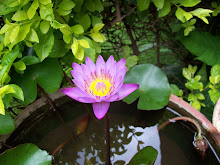 The Indigo plant, INdigofera tinctoria is a native wild plant which grows throughout India.Although the dye obtained from it is blue, the flowers of Indigofera tinctoria are mauve or pink. Indigo has a long history as a dye. It was so valuable that it was called the Blue Gold.Newton named one of the colours of the spectrum after the colour of the dye.
The Indigo plant, INdigofera tinctoria is a native wild plant which grows throughout India.Although the dye obtained from it is blue, the flowers of Indigofera tinctoria are mauve or pink. Indigo has a long history as a dye. It was so valuable that it was called the Blue Gold.Newton named one of the colours of the spectrum after the colour of the dye.Although many plants belong to the Indigofera family, it is the Indigofera tinctoria which was used historically to obtain the blue dye. The leaves of the Indigo plant are boiled and allowed to ferment to obtain the dye.

The Indigo Revolt of 1858 in Bengal was considered by many historians as the precursor to the struggle for independence in India . The British East India Company, forced the farmers of Bengal to grow indigo instead of food crops , which led to mass revolt by the farmers. The famousBengali play , Neel Darpan is based on this revolt. In 1897, Indigo was grown in 7000 square kilometers . Even though they produced 19,000 tons of the precious dye for their foreign masters, the conditions the farmers lived in were abysmal. Everything changed suddenly, when the commercially viable synthetic indigo dye was synthesised in 1860.
Indigo has been used since pre historic times to dye cloth. The Greeks and Romans valued it as a luxury dye brought from India. In Japan, the summer Kimono Yukata, is dyed blue using Indigo, as it represents nature and the blue ocean. In America, the blue jeans were dyed with indigo. In India, indigo has been used to dye silk and cotton.
In Indian alternative medicine, Indigo plant is used for alleviating pain.
The plant is known for its soil improving properties.




Aaron:Now all the indigo produced is synthetic.
ReplyDeleteI have admired this plant in gardening books - and I've just seen it once for sale though decided against the purchase as I thought it was too tender for my garden conditions. Great information lotusleaf.
ReplyDeleteVery interesting post. I have been admiring the balsams in your earlier post, too!
ReplyDeleteThe indigo coloured fabindia kurtas are my favourite.
ReplyDeleteIt's all in a plant. It was interesting to read.
ReplyDeleteThe farmers were right to revolt, I hope they do now against GM food. It won't do them any good if they can not save their own seed. I hate to see everything in the hands of Monsanto.
This is so interesting and an eye opener for me. I didn't know that indigo is a plant!
ReplyDelete